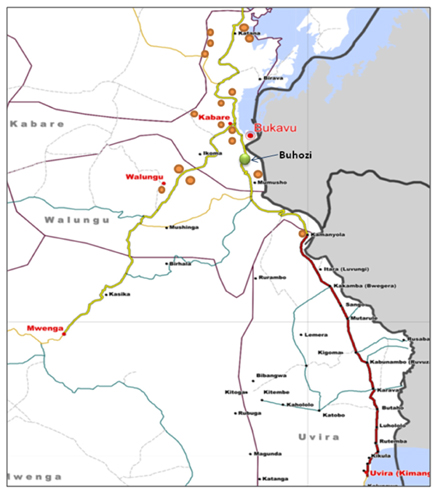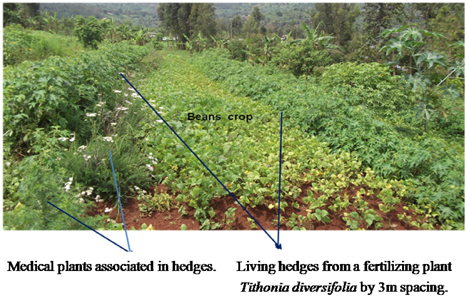Nutr Res Pract.
2013 Dec;7(6):510-518.
The cultivation of wild food and medicinal plants for improving community livelihood: The case of the Buhozi site, DR Congo
- Affiliations
-
- 1Universite Libre des pays des Grands Lacs, Faculte de sante et developpement Communautaires, Democratic Republic of Congo.
- 2Centre de Recherches Universitaire du Kivu (CERUKI), Institut Superieur Pedagogique (ISP) de Bukavu, Democratic Republic of Congo.
- 3Department of Chemistry, Soonchunhyang University, Asan, Chungnam 336-745, Korea.
- 4Department of Food Science and Nutrition, Soonchunhyang University, 22 Soonchunhyang-ro, Asan, Chungnam 336-745, Korea. hskim1@sch.ac.kr
Abstract
- This study aims to demonstrate the effect of farming technology on introducing medicinal plants (MP) and wild food plants (WFP) into a traditional agricultural system within peri-urban zones. Field investigations and semi-structured focus group interviews conducted in the Buhozi community showed that 27 health and nutrition problems dominated in the community, and could be treated with 86 domestic plant species. The selected domestic MP and WFP species were collected in the broad neighboring areas of the Buhozi site, and introduced to the experimental field of beans and maize crops in Buhozi. Among the 86 plants introduced, 37 species are confirmed as having both medicinal and nutritional properties, 47 species with medicinal, and 2 species with nutritional properties. The field is arranged in a way that living hedges made from Tithonia diversifolia provide bio-fertilizers to the plants growing along the hedges. The harvest of farming crops does not disturb the MP or WFP, and vice-versa. After harvesting the integrated plants, the community could gain about 40 times higher income, than from harvesting farming crops only. This kind of field may be used throughout the year, to provide both natural medicines and foods. It may therefore contribute to increasing small-scale crop producers' livelihood, while promoting biodiversity conservation. This model needs to be deeply documented, for further pharmaceutical and nutritional use.
Keyword
MeSH Terms
Figure
Reference
-
1. Timberlake L. Africa in Crisis: the Causes, the Cures of Environmental Bankruptcy. Washington, D.C.: International Institute for Environment and Development;1985. p. 232.2. Jayne TS, Mather D, Mghenyi E. Principal challenges confronting smallholder agriculture in sub-Saharan Africa. World Dev. 2010; 38:1384–1398.
Article3. Isumbisho M, Balagizi K, Mapatano M, Niyonkuru D. Gouvernance des Ressources Naturelles Collectives des Ecosystèmes Fragiles dans la Région des Grands Lacs Africains. Bukavu: Centre de Recherches Universitaires du Kivu;2013. p. 461.4. Martini M. République Démocratique du Congo: Analyse de la Sécurité Alimentaire et de la Vulnérabilité - Collecte et Analyse des Informations Secondaires (CFSVA). Rome: Programme Alimentaire Mondial;2005. p. 66.5. Gaye D. Pauvreté Rurale et insécurité Alimentaire au Sud-Kivu: Situation de Milieux Précarisés à l'Est de la République Démocratique du CongoPediatr Allergy Immuno. Louvain-la-Neuve: Louvain Développement;2005. p. 128.6. Programme des Nations Unies pour le Développement, Unité de lutte contre la pauvreté (CD). Province du Sud Kivu Profil Resume: Pauvrete et Conditions de vie des Menages. Kinshasa: Programme des Nations Unies pour le Développement;2009. p. 20.7. Bashibarhishindi K. L'impact socio-économique du métier des tradipraticiens dans le district sanitaire de Bukavu. Mémoire de licence [master's thesis]. Goma: Université Libre des Pays des Grands Lacs;2012.8. Katwanyi K, Adhama M, Balagizi K, Limbuko M, Murhula G, Guhanika B, Kasaza D. Etude de base de la Sécurité Alim en Milieu Périurbain des Territoires de Kabare et Walungu, Rapport Technique. Berlin: Pain pour le Monde;2013. p. 67.9. Reed MS, Graves A, Dandy N, Posthumus H, Hubacek K, Morris J, Prell C, Quinn CH, Stringer LC. Who's in and why? A typology of stakeholder analysis methods for natural resource management. J Environ Manage. 2009; 90:1933–1949.
Article10. Balagizi K, Mapatano M, Polepole P, Cizungu M, Cihyoka MA. Recueil des Pratiques et Savoirs Locaux Document Technique. Bukavu: DIOBASS;2010. p. 265.11. Scoones I, Thompson J. La Reconnaissance du Savoir Rural: Savoir des Populations, Recherche Agricole et Vulgarisation. Paris: Karthala;1999. p. 474.12. Letouzey R. Manuel de Botanique Forestière: Afrique Tropicale. Botanique Générale. Paris: Centre Technique Forestier Tropical;1982. Vol. 1:p. 460.13. Joy PP, Thomas J, Mathew S, Skaria BP. Medicinal Plants. Kerala: Kerala Agricultural University;1998. p. 211.14. Maundu P, Katende K, Tegnas B. Wildfood Plants of Uganda. Nairobi: World Agroforestry Centre;1997. p. 345.15. Centre de Coopération Internationale en Recherche Agronomique pour le Développement. Groupe de Recherche et d'Échanges Technologiques (FR). Memento de l'Agronome. Paris: Centre de Coopération Internationale en Recherche Agronomique pour le Développement;2002.16. Amponsah K, Crensil OR, Odamtten GT, Ofusohene-Djan W. Manual for the Propagation and Cultivation of Medicinal Plants of Ghana. Aburi: Darwin Initiative;2002. p. 32.17. Troupin G. Flore du Rwanda: Spermatophytes. Tervuren: Musée royal de l'Afrique centrale;1983. Vol. II:p. 603.18. Troupin G, Ayobangira FX, Bridson D, Champluvier D, Lawalree A, Malaise P, Maquet P, Reekmans M, Schotsmans H, Verdcourt B. Flore du Rwanda: Spermatophytes. Tervuren: Musée royal de l'Afrique centrale;1985. Vol. III:p. 744.19. Troupin G, Champluvier D, Geerinck D, Malaise P, Maquet P. Flore du Rwanda: Spermatophytes. Tervuren: Musée royal de l'Afrique centrale;1988. Vol. IV:p. 662.20. Lisowski S. Flore d'Afrique centrale (Zaïre-Rwanda-Burundi): Spermatophytes. Compositae (Part 2): Tribe Inuleae. Meise: National Botanic Garden of Belgium;1989. p. 239.21. Agnew AD, Agnew S. Upland Kenya Wild Flowers: a Flora of the Ferns and Herbaceous Flowering Plants of Upland Kenya. 2nd ed. Nairobi: East Africa Natural History society;1994. p. 374.22. Fischer E, Killmann D. llustrated fie ld guide to the Plants of Nyungwe National Park Rwanda. Koblenz: University of Koblenz-Landau;2009. p. 771.23. Defour G. Eléments d'Identification de 400 Plantes Médicinales et Vétérinaires du Bushi. Bukavu: Editions Bandari;1995. p. 125.24. Co LL. Common Medicinal Plants of the Cordillera Region (Northern Luzon, Philippines): a Trainor's Manual for Community Based Health Programs. Baguio: Community Health Education, Services and Training in the Cordillera Region;1989. p. 487.25. Balagizi K, Halisombe K. Plantes du Kivu à Usage Alimentaires et Médicinales. Quezon: Council for Extension, Research and Development in Agriculture and Fisheries;2000.26. Neuwinger HD. African Traditional Medicine. A Dictionary of Plant Use and Applications with Supplement: Search System for Diseases. Stuttgart: Medpharm Scientific Publishers;2000. p. 600.27. Balagizi KI, Kambale VE, Ratti E. Les Plantes Médicinales du Bushi. Genova: Auslieferungsstelle des Buches Emiliani-Rapallo;2006. p. 315.28. Oxfam Novib (NL). Organigramme. Un Avenir Équitable d'Abord: Plan Institutionnel d'Oxfam Novib 2011-2015. The Hague: Oxfam Novib;2011. p. 35.29. Hirt HM, M'Pia B HM. La Médecine Naturelle Tropicale: Livre de Poche Pratique pour les Médecins, Tradi-Praticiens et Infirmiers: Comment se Soigner Avec les Plantes Tropicales?: Comment Fabriquer Soi-Même des Médicaments et des Produits Cosmé tiques? Winnenden: Anamed;2004. p. 128.30. Neema B. Etude des facteurs favorisant au recours des patients à la Médecine traditionnelle dans la ville de Bukavu. Mémoire de Licence [master's thesis]. Goma: Université Libre des Pays des Grands Lacs;2013.31. Wiersum KF, Dold AP, Husselman M, Cocks M. Cultivation of medicinal plants as a tool for biodiversity conservation and poverty alleviation in the Amatola Region, South Africa. In : Bogers RJ, Craker LE, Lange D, editors. Medicinal and Aromatic Plants: Agricultural, Commercial, Ecological, Legal, Pharmacological and Social Aspects. Dordrecht: Springer;2006. p. 43–57.32. Biswas BC. Cultivation of medicinal plant. Success stories of two farmers. Fertili Mark News. 2010; 41:1–4. 2033. Phondani PC, Negi VS, Bhatt ID, Maikhuri RK, Kothyari BP. Promotion of medicinal and aromatic plants cultivation for improving livelihood security: a case study from West Himalaya, India. Int J Med Aromat Plants. 2011; 1:245–252.34. Rajeswara Rao BR, Syamasundar KV, Rajput DK, Nagaraju G, Adinarayana G. Biodiversity, conservation and cultivation of medicinal plants. J Pharmacogn. 2012; 3:59–62.35. Amujoyegbe BJ, Agbedahunsi JM, Amujoyegbe OO. Cultivation of medicinal plants in developing nations: means of conservation and poverty alleviation. Int J Med Aromat Plants. 2012; 2:345–353.36. Garza E. Guide to natural Remedies for Health and well-being. Mexico: Orvit Publishing;1998. p. 426.37. Duke JA, Bogenschutz-Godwin MJ, duCellier J, Duke PA. Handbook of medicinal Herbs. 2nd edition. Boca Raton (FL): CRC Press;2002. p. 870.38. Pamplona-Roger GD. Santé par les Plantes Médicinales. Madrid: Editorial Safeliz;2009. p. 383.39. Koh K, Kim S, Balagizi K, Park EH, Kim B, Kim HS. Screening African ethnic plants for possible medicinal or nutritional values. In : Singapore: Proceedings of 11th Asian Congress of Nutrition; 2011 July 13-16; Singapore. Singapore: Federation of Asian Nutrition Societies;2011.40. Kim HS, Koh K, Park EH, Balagizi K, Kim HJ. Evaluation of Antioxidant Properties of the Stem Bark of Harungana Madagascariensis Lam. Ex. Poir (Clusiaceae) from Eastern DR Congo. San Diego (CA): Federation of American Societies for Experimental Biology;2012.41. Adhama M, Balagizi K, Mushagalusa BT. Rapport Technique sur la Recherche sur les Plantes Médicinales et Alimentaires de l'ULPGL. Texte Présenté à l'Exposition de la Francophonie. Goma: Université Libre des Pays des Grands Lacs;2013. p. 25.42. Plant Resources of Tropical Africa (NL). Liste de Base des Espèces et de Leurs Groupes d'Usages. Wageningen: Plant Resources of Tropical Africa;2012. p. 341.43. Isumbisho M, Balagizi K, Mapatano M, Niyonkuru D. Gouvernance des Ressources Naturelles Collectives des Ecosystèmes Fragiles dans la Région des Grands Lacs Africains. Bukavu: Centre de Recherches Universitaires du Kivu;2013. p. 421.44. Kaho F, Yemefack M, Feujio-Teguefouet P, Tchantchaouang JC. Effet combiné des feuilles de Tithonia diversifolia et des engrais inorganiques sur les rendements du maïs et les propriétés d'un sol ferralitique au Centre Cameroun. Tropicultura. 2011; 29:39–45.45. Shabidullah AKM, Haque CE. Linking medicinal plant production with livelihood enhancement in Bangladesh: implications of a vertically integrated value chain. J Transdiscipl Environ Stud. 2010; 9:1–18.
- Full Text Links
- Actions
-
Cited
- CITED
-
- Close
- Share
- Similar articles
-
- Anti-carcinogenic and Anti-bacterial Properties of Selected Spices: Implications in Oral Health
- An experimental study for the evaluation of hemopoietic effects of 9 medicinal plants used in herbal drugs
- Development of Drink from Composition with Medicinal Plants and Evaluation of Its Physiological Function
- Revisit to the Safety of Medicinal Herb
- Investigation of the Conditions and Evaluation of the Benefits of the Foodbank Program from the Recipients' Perspective



